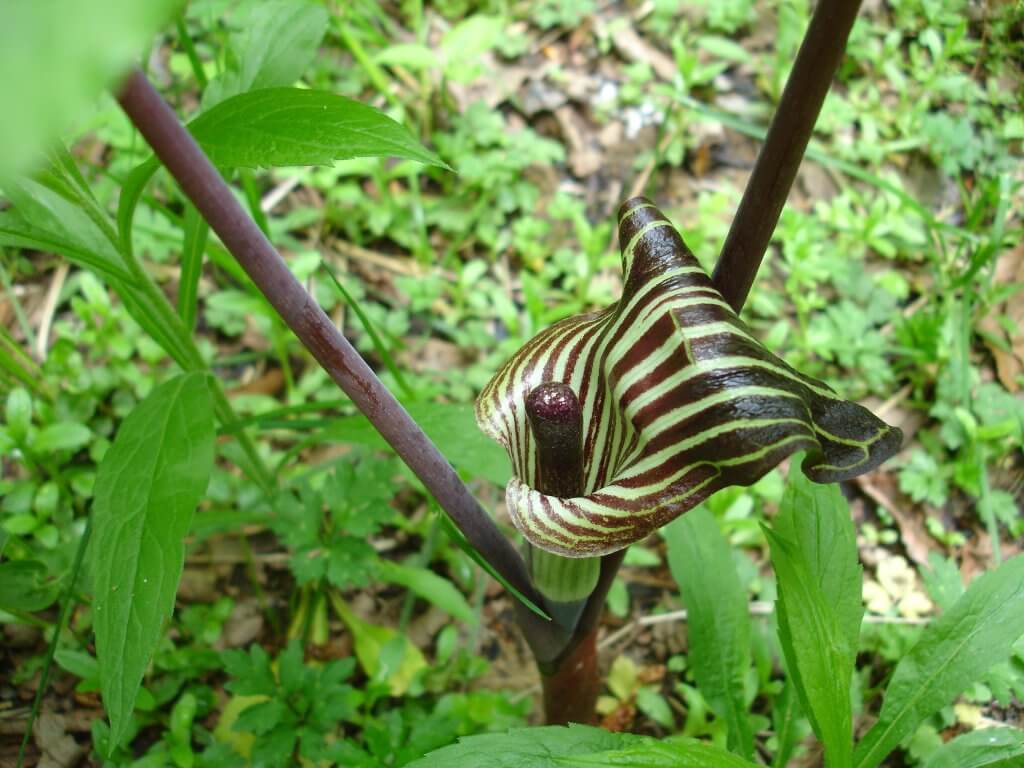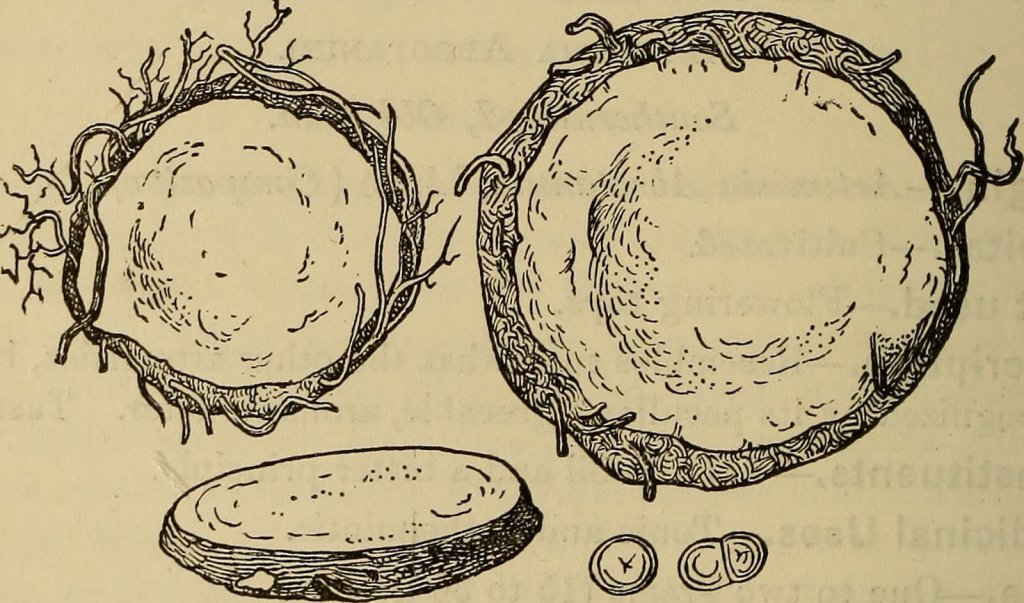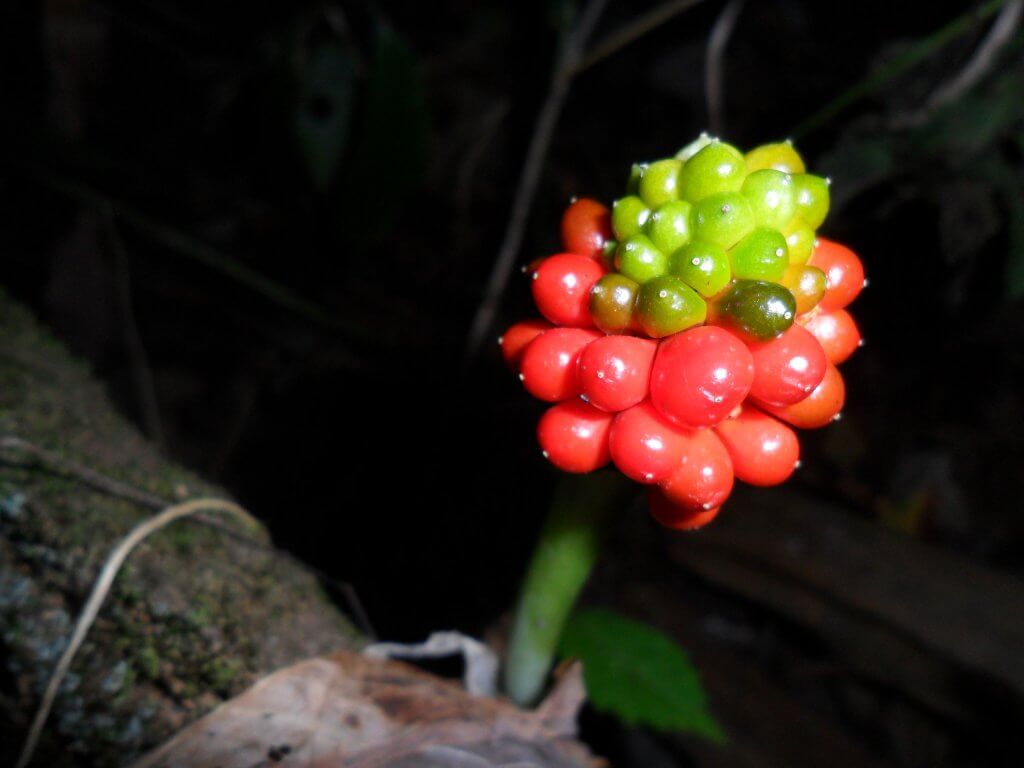Jack in the Pulpit (Arisaema triphyllum) is a wild edible, perennial plant suited best to foragers with a little more expertise. It is also widely known as Indian turnip, dragon turnip and bog onion. Native to Northeast and Midwest America. You will tend to find them growing in areas of high moisture, like forest lowlands and near the banks of rivers and streams. Below the surface of the soil, this plant bears a corm, a tuber-like stem, very swollen in size.
From the corm, a stem emerges with 3 pointed leaves growing together to a maximum of 12cm in length and 5cm wide. When flowering in Spring you will see a tall hoodlike structure encompassing a ‘spadix’, which is a narrow stalk bearing a collection of tiny flowers. The hoodlike structure, or ‘spathe’, is often striped in shades of green, purple or brown vertical stripes. Typically the plant will reach no more than 60cm in height. During the fall the leaves and inflorescence die away to reveal a glossy collection of bright red berries.
It was likely named for its appearance of the spadix stalk resembling a solitary figure within a raised and enclosed pulpit.

Edible parts and other uses
The peppery tasting corms of Jack the pulpit are where the nutrition and taste can be found, but please do read on to the cautions below for the attention needed to prepare them for consumption.
When sliced and thoroughly dried, they can be eaten like crisps or ground into a flour. This flour can be used to bake cakes or sweet treats and is said to have a mild chocolate like flavor.
The berries are toxic so are not considered edible, however native Americans did once use their red coloring as a dye.
Foraging
Identifying the plant is fairly easy when flowers are present. However care must be taken if identifying using leaves only. Toxic lookalikes include poison ivy.
The plant can alternate between male or female, and this will determine the size of the corm. You can harvest the corms throughout the year, however the corms will be bigger during early spring if the plant is female, and late summer/fall for for male plants. The female plants will usually have two stems each bearing 3 leaves, and the male will have one stem and only 3 leaves.

Cautions
Throughout the raw plant there are varying quantities of calcium oxalate. A sharp needle-like crystalline chemical that can cause serious discomfort throughout the digestive system. From burning the inside of your mouth to causing small blockages that may form kidney stones.
Although this sounds rather worrying, the plant can be safely consumed if the corm has been thinly sliced and dried in a dehydrator or slow oven for 7 days. Or sliced and boiled through to absolute certainty, however this can take the best part of half a day to breakdown the calcium oxalate. It is always best to test and spit out a tiny quantity after preparation, to be sure you do not experience a burning sensation in the mouth. Cooking with Jack in the pulpit takes consideration and care.
The rest of the plant is considered toxic, so please only process and dry the corms. Also be sure to watch out for any poison ivy as the leaf shapes can look similar. Especially when the easily identifiable flowers are not in bloom.

Did you know…
Many stories have emerged of the ways native Americans utilised Jack in the pulpit. One story of note explains that the corm was once mixed with meat and left for enemies to discover. The burning sensation is not instant, meaning a great quantity could be consumed without knowing. This would later leave their enemies in great discomfort, and in many cases even cause death.
Conclusion
Jack in the pulpit is not likely to replace your usual flour or snack supplies. It is however an interesting plant to experiment with. After careful and safe preparation, the corm can be used in a variety of ways. With its lightly peppered and chocolate malt like taste, it could create some interesting sweet bakes. But please do take care when foraging or preparing.
—————Written by Hannah Sweet
Hannah is a freelance writer and graphic designer from the UK. With a penchant for travelling, photography and all things botanical, she enjoys writing about a wealth of topics and issues, from conservation and slow living, to design and travel. Learn more about her writing and design services at www.sweetmeanders.co
Many of our readers find that subscribing to Eat The Planet is the best way to make sure they don't miss any of our valuable information about wild edibles.
See our privacy policy for more information about ads on this site







2 Responses
The internet is loaded with articles about its purported edibility, all a variation on “some Native Americans ate the root after drying it for six months, then roasting it” (or roasting it, then drying it for six months). No one actually eats this.
Here’s a link to the ONLY reference I could find to someone trying to render this plant edible, and it was not very successful!
http://www.eattheweeds.com/arisaema-triphyllum-jack-and-jill-and-no-hill-2/
“Mixing it with meat” for native people’s enemies to find seems pretty unlikely…
I ate a raw piece when I was about 6 yrs old. I begged my dad to try it. It felt like I was getting my tongue tattooed. It went from hot to the worse pain. I remember it very vividly.